Table of Contents
- Introduction
- Editor’s Choice
- General Machine Tools Statistics
- Laser Statistics
- History of Laser Cutting Technology
- Types of Lasers Used for Cutting
- Laser Cutting Machine Market Statistics
- Key Export Statistics
- Key Import Statistics
- Laser Cutting Machine Specifications Statistics
- Laser Cutting Carbon Steel with Assist Air Gas
- Innovations in Laser Cutting Technology
- Regulations for Laser Cutting
- Recent Developments
- Conclusion
- FAQs
Introduction
Laser Cutting Machine Statistics: Laser-cutting machines use focused, high-powered laser beams to cut and shape materials precisely.
They consist of a laser source (either CO2 or fiber), and optics for beam direction. A cutting head, a motion system for movement, and a control system for operation.
CO2 lasers are versatile for non-metals like plastics and wood. While fiber lasers are efficient for metals such as steel and aluminum.
The advantages include high precision, speed, and minimal waste, though limitations include material thickness constraints and high initial costs. Safety measures are essential to protect operators from laser exposure and to manage fumes.
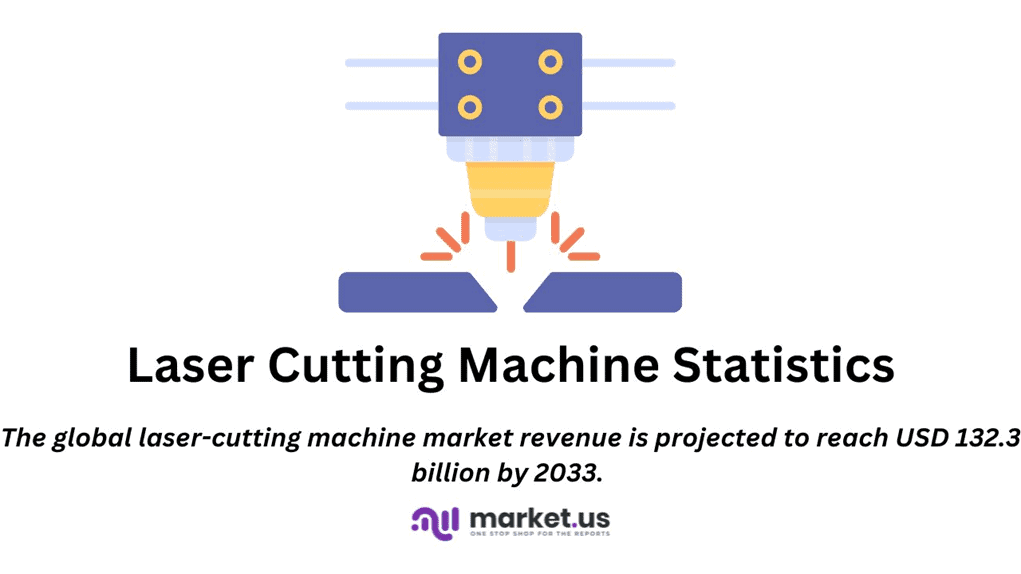
Editor’s Choice
- Global laser sales achieved a value of USD 18.48 billion in 2021.
- The advent of 3D laser cutting occurred in 1979 with the introduction of a five-axis rotation system.
- The global laser-cutting machine market revenue is projected to reach USD 132.3 billion by 2033.
- In the United States laser cutting machine market in 2016, low-power fiber lasers dominated with a substantial market share of 61.03%.
- In 2019, the global laser-cutting machine market was dominated by IPG. Which held a commanding 46.79% share of the market.
- In 2019, the global laser-cutting machine market. It was primarily driven by material processing and lithography applications. Which together accounted for 44.3% of the market share.
- In 2022, Germany emerged as the leading exporter of electric, laser, and ultrasonic welding equipment, with an export value of USD 732 million, accounting for 24.3% of the global market.
- In 2022, the United States was the largest importer of electric, laser, and ultrasonic welding equipment, with an import value of USD 489 million, accounting for 16.3% of the global market.
- The Fiber Laser Cutting Machine FOL-3015AJ is a high-performance model equipped with a 4000W fiber laser. Designed for precision and versatility in material cutting.
- In the European Union, laser devices, including those used for cutting, must adhere to several stringent standards. Such as EN 60825 for laser product safety, which classifies devices based on their hazard levels and sets out specific requirements to mitigate risks.
General Machine Tools Statistics
Machine Tools Production Worldwide
- The machine tools production market experienced fluctuations in value from 2011 to 2021.
- Starting at USD 88.1 billion in 2011, the market saw a slight increase to USD 89.2 billion in 2012, followed by a decline to USD 81 billion in 2013.
- In 2014, the value rose to USD 84.8 billion, only to drop back to USD 81 billion in 2015 and further to USD 79.2 billion in 2016.
- A recovery was observed in 2017, with production value increasing to USD 86.5 billion, and this growth continued into 2018, reaching USD 93 billion, the highest within this period.
- However, the market saw another decline in 2019 to USD 82.3 billion and a significant drop in 2020 to USD 67.7 billion, largely influenced by global economic conditions.
- By 2021, the market rebounded to USD 83.9 billion, reflecting a partial recovery. These variations highlight the sector’s sensitivity to global economic changes and market demand.
(Source: Statista)
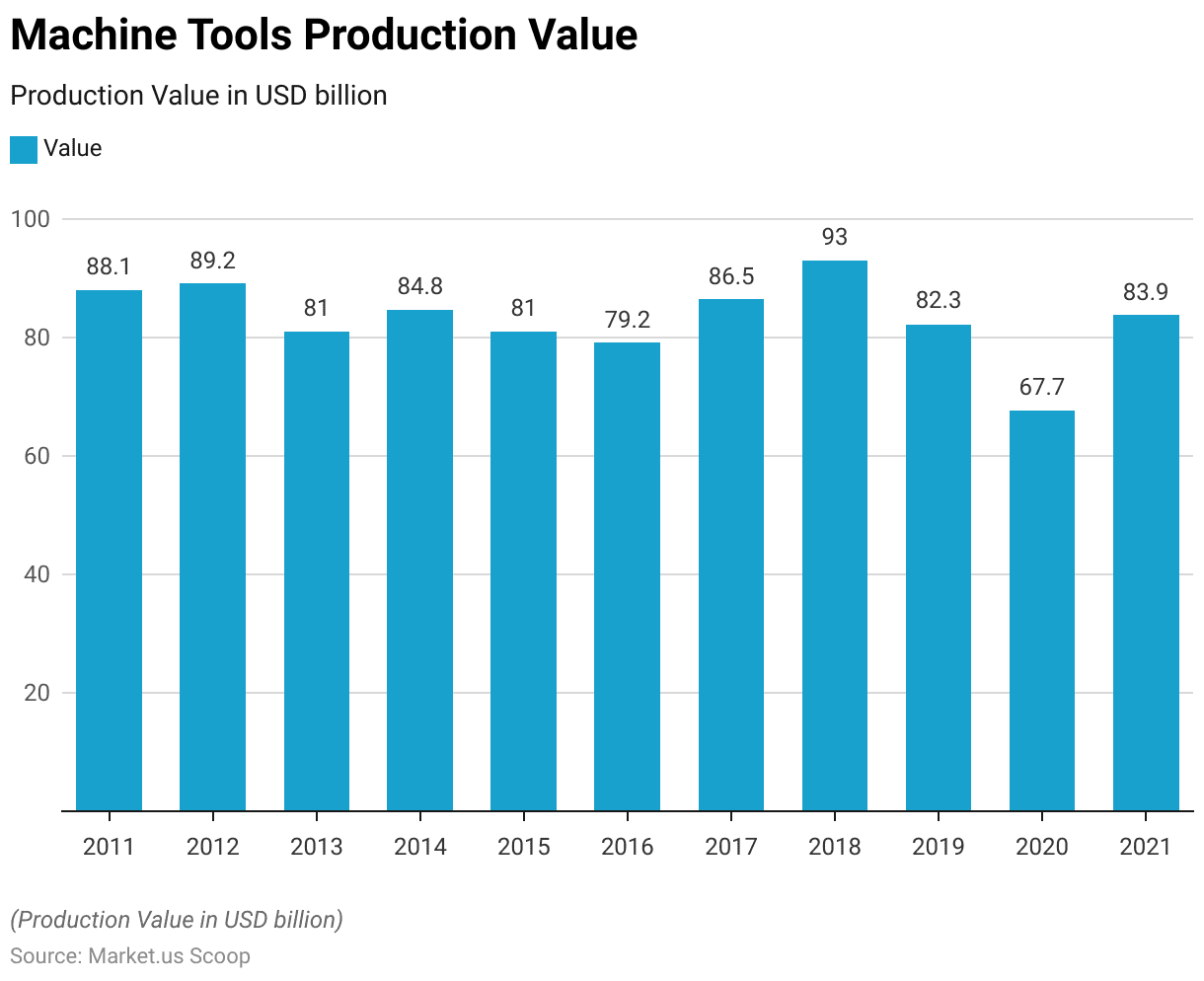
Leading Countries in Machine Tool Production – By Market Share
- In 2021, China dominated the machine tool production market, holding a substantial 31% share. Reflecting its position as the leading global producer.
- Japan and Germany each contributed 13% to the market, showcasing their strong industrial bases and advanced manufacturing capabilities.
- The United States accounted for 9% of the market share, followed by Italy with 8%.
- Other countries collectively made up the remaining 27%. Indicating a diverse range of producers contributing to the global machine tool industry.
- This distribution underscores the significant role of Asian and European countries in the global machine tool market.
(Source: Statista)
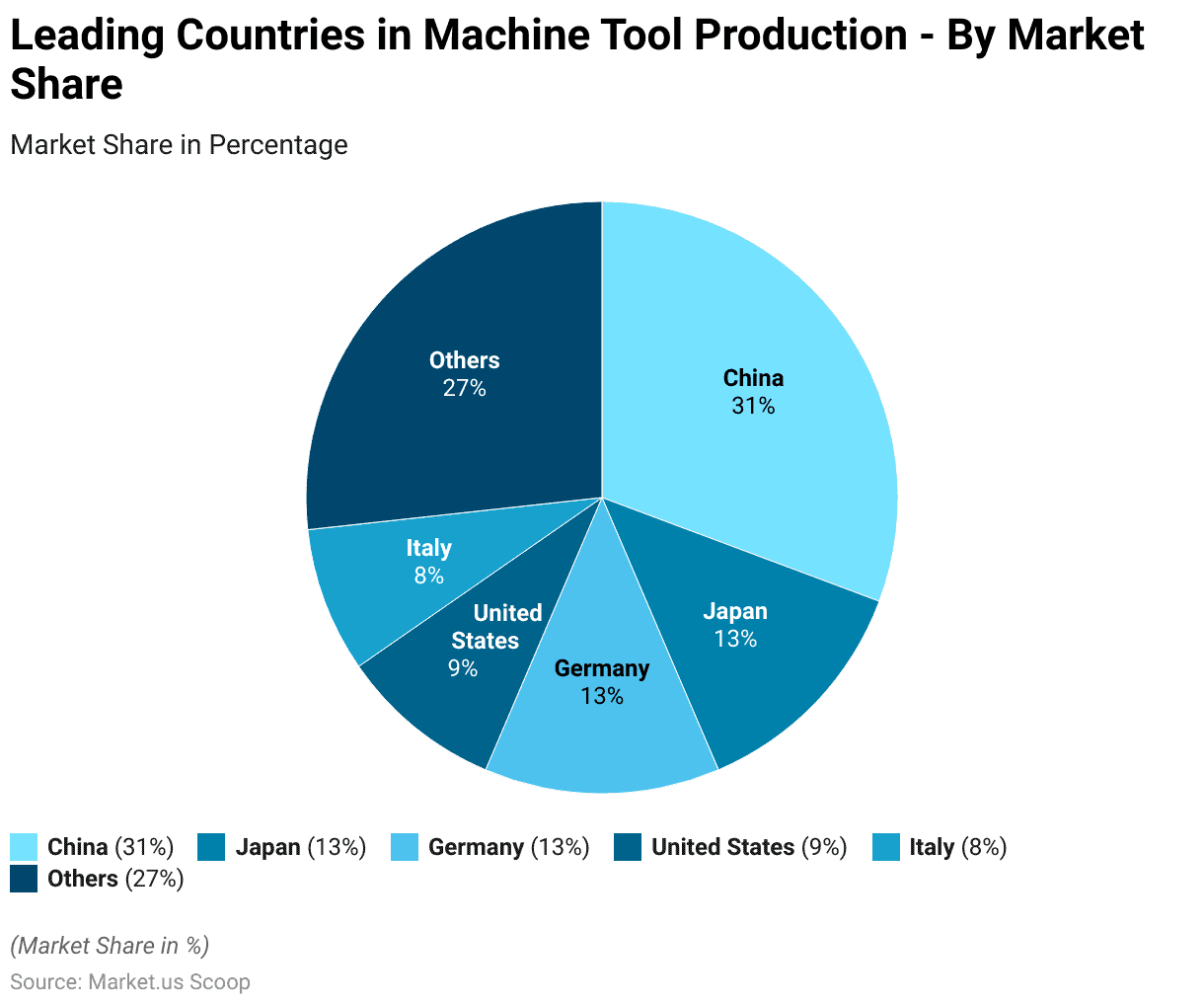
Laser Statistics
Global Laser Sales
- Global laser sales experienced consistent growth from 2016 to 2021, with revenue increasing from USD 11.56 billion in 2016 to USD 18.48 billion in 2021.
- The market saw a significant rise in 2017, with sales reaching USD 13.77 billion. Followed by further growth in 2018 to USD 14.94 billion.
- Although there was a slight decline in 2019 to USD 14.72 billion. The market quickly rebounded in 2020, achieving sales of USD 16.01 billion.
- This upward trajectory continued into 2021, culminating in a substantial increase to USD 18.48 billion. Reflecting the growing demand and advancements in laser technology globally.
(Source: Statista)
Take advantage of our unbeatable offer - buy now!

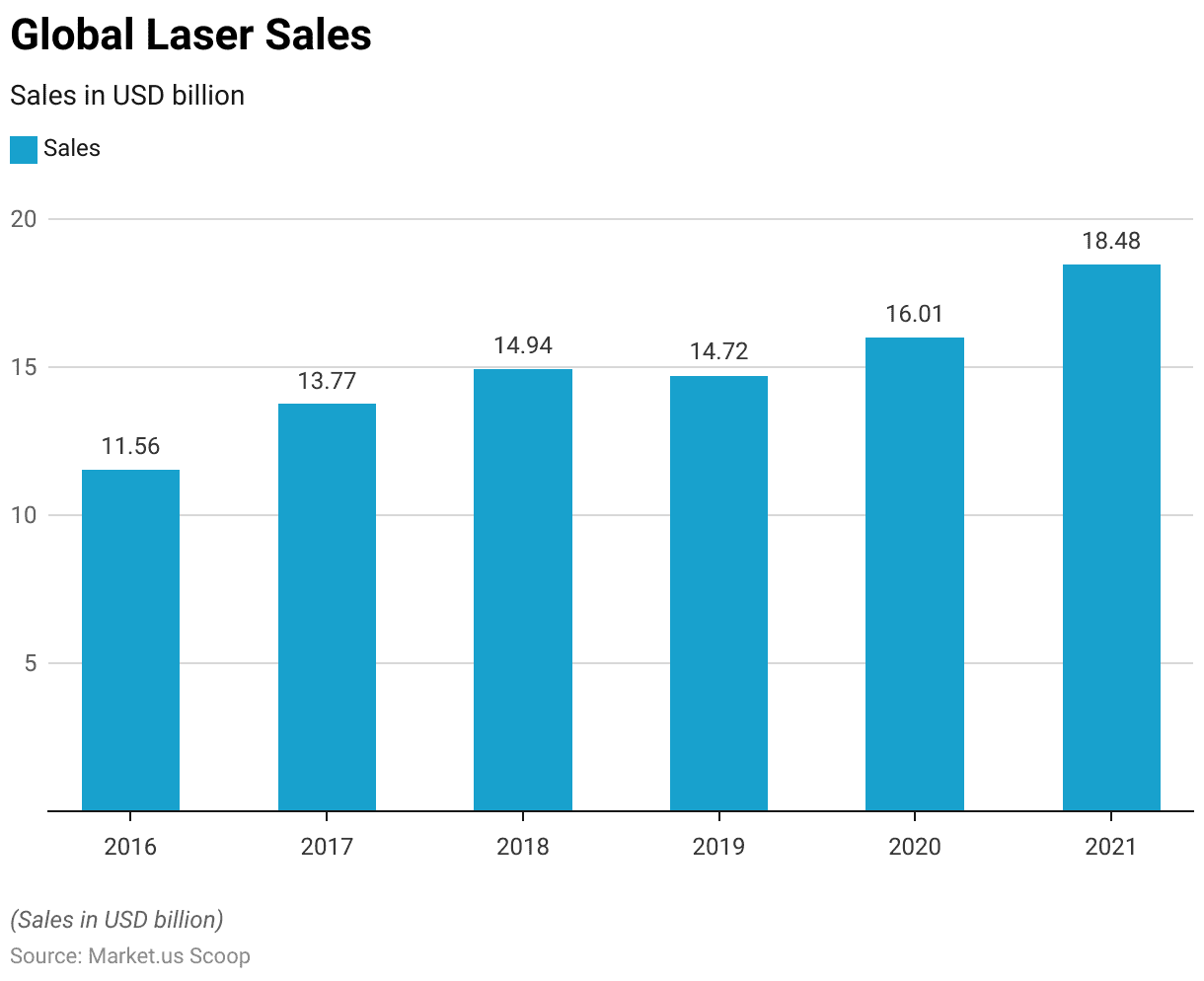
Laser Applications
- In 2016, the global laser market was primarily driven by the communications sector. Which accounted for 34% of the market share.
- Materials processing was the second-largest application, contributing 30% to the overall market.
- Lithography held a 9% share, while scientific research and military applications. As well as medical and aesthetic uses, each represented 8% of the market.
- Instrumentation and sensors comprised 6% of the market, with optical storage and displays each holding 2%.
- The printing sector accounted for the remaining 1% of the market.
- This distribution highlights the diverse applications of laser technology across various industries. With a particular emphasis on communications and materials processing.
(Source: Statista)
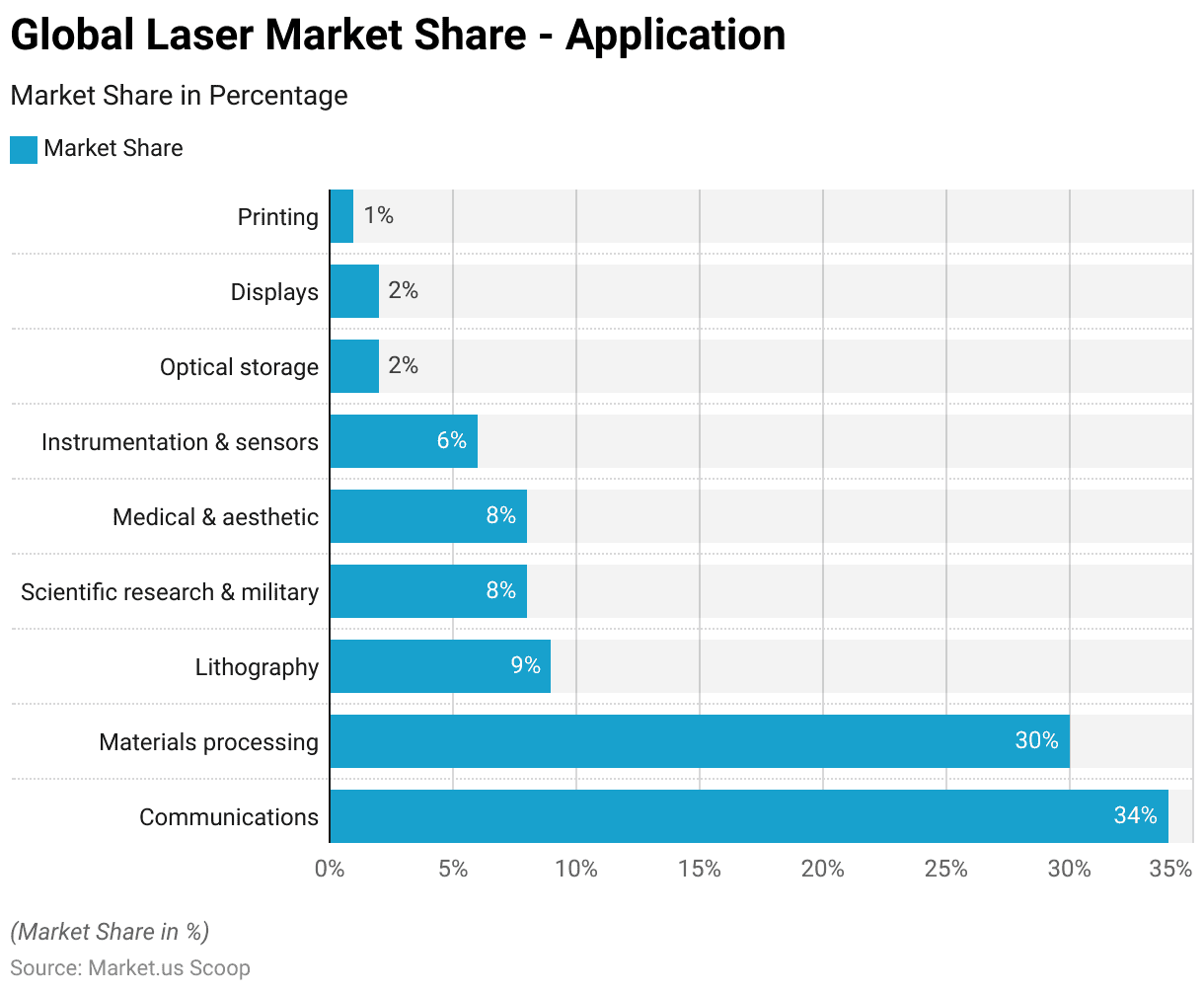
History of Laser Cutting Technology
- The initial concept linking energy to the frequency of radiation was formulated by physicist Max Planck in 1900. Who proposed that energy could only be emitted or absorbed in discrete quantities.
- This theory was further developed by Albert Einstein in 1905 with his study on the photoelectric effect. In 1917, Einstein introduced the concept of stimulated emission, which underpins laser technology.
- It was not until 1954 that Einstein’s theory was experimentally validated, thanks to Charles Hard Townes, along with Herbert J. Zeiger and James P. Gordon.
- Initially, laser strength was measured in ‘gillettes,’ referring to the number of razor blades a laser could cut through. Today, the most powerful lasers are equivalent to the energy of a hydrogen bomb.
- The acronym LASER stands for Light Amplification by Stimulated Emission of Radiation, a term coined by Gordon Gould in 1959.
- The ruby laser was first utilized for cutting purposes in 1965, specifically to drill holes in diamond dies.
- In 1963, Kumar Patel developed the carbon dioxide (CO2) laser, which proved more powerful and cost-effective than the ruby laser. The CO2 laser was first employed for metal cutting in 1967, and it was used in conjunction with oxygen jet cutting to slice through a 1mm thick steel sheet.
- In 1970, The Being Company pioneered laser cutting technology in manufacturing. Introducing multi-beam laser cutting to handle tough materials such as titanium.
- The advent of 3D laser cutting occurred in 1979 with the introduction of a five-axis rotation system.
- Laser cutting is celebrated for its precision, with laser measurements achieving accuracy to just over a nanometre (a billionth of a meter).
(Source: ACRA)
Types of Lasers Used for Cutting
CO2 Lasers
- CO2 lasers are frequently employed in laser cutting due to their favorable power-to-cost ratio compared to solid-state lasers.
- Additionally, CO2 lasers deliver superior beam quality at elevated power levels. However, a notable drawback is their emission wavelength of 10.7 μm. Which cannot be transmitted through optical fibers.
- Consequently, CO2 lasers are predominantly utilized for cutting ferrous materials using either 2D or 3D specialized cutting equipment.
(Source: Science Direct)
Solid State Lasers
- Solid-state lasers are typically costlier than CO2 lasers of equivalent power.
- They emit a beam with a wavelength ranging from 1.05 to 1.07 μm, which can be transmitted through optical fibers.
- This capability allows for the integration of the cutting head into robotic systems or other machinery that can guide the head, enabling beam transport via fiber.
- Furthermore, this wavelength is more effectively absorbed by non-ferrous materials such as aluminum, titanium alloys, and nickel.
- Consequently, solid-state lasers are frequently utilized in automated production lines where robots perform the cutting tasks.
(Source: Science Direct)
Laser Cutting Machine Market Statistics
Global Laser Cutting Machine Market Size Statistics
- The global laser-cutting machine market has exhibited significant growth over the past years at a CAGR of 8.7%. With revenue increasing from USD 52.8 billion in 2022 to USD 57.4 billion in 2023.
- This upward trend is projected to continue, with market revenue expected to reach USD 62.4 billion in 2024 and USD 67.8 billion in 2025.
- By 2026, the market is anticipated to generate USD 73.7 billion. Further expanding to USD 80.1 billion in 2027 and USD 87.1 billion in 2028.
- The market is forecasted to maintain its robust growth. With revenues climbing to USD 94.7 billion by 2029 and USD 102.9 billion by 2030.
- In the subsequent years, the global laser cutting machine market is expected to reach USD 111.9 billion in 2031, USD 121.6 billion in 2032, and USD 132.3 billion by 2033. Highlighting the sustained demand and technological advancements in this sector.
(Source: market.us)
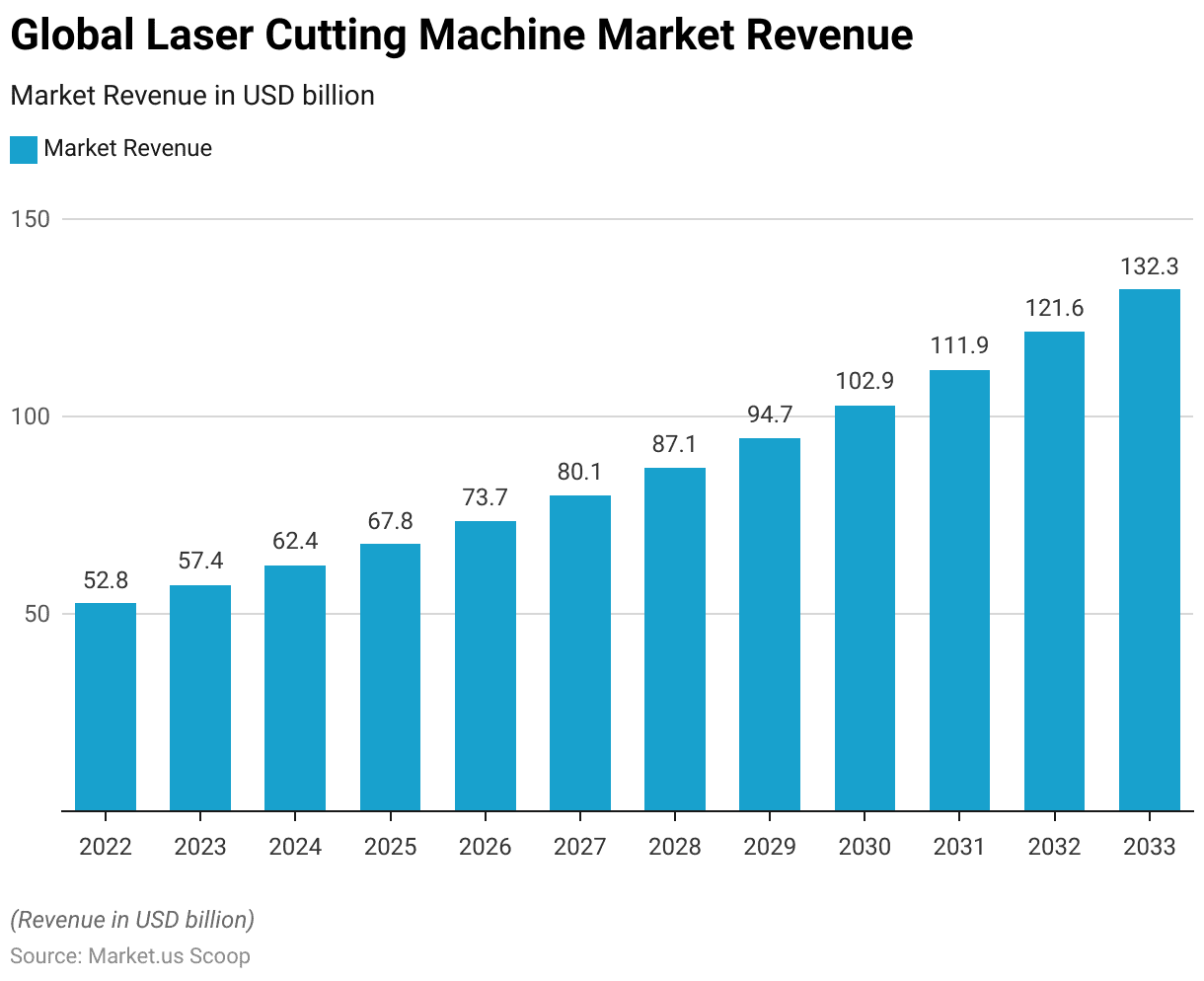
Laser Cutting Machine Market Share – By Product Statistics
- In the United States laser cutting machine market in 2016, low-power fiber lasers dominated with a substantial market share of 61.03%.
- Low-power CO2 lasers accounted for 14.70% of the market. Followed closely by low-power solid-state lasers, which held a 13.29% share.
- Other types of laser-cutting machines collectively represented 10.98% of the market.
- This distribution underscores the strong preference for low-power fiber lasers within the US market during this period, reflecting their efficiency and versatility in various applications.
(Source: Statista)

Global Laser Cutting Machine Market Share – By Source Statistics
- In 2019, the global laser-cutting machine market was dominated by IPG. Which held a commanding 46.79% share of the market.
- Raycus followed with a 10.26% market share, while Nlight accounted for 6.29%.
- MAX contributed 3.61% to the market, and JPT held 2.9%.
- Other sources collectively made up the remaining 30.16% of the market.
- This distribution underscores the significant influence of IPG in the industry. While also highlighting the presence of other key players contributing to the diversity of laser sources in the market.
(Source: BLMA Machinery)
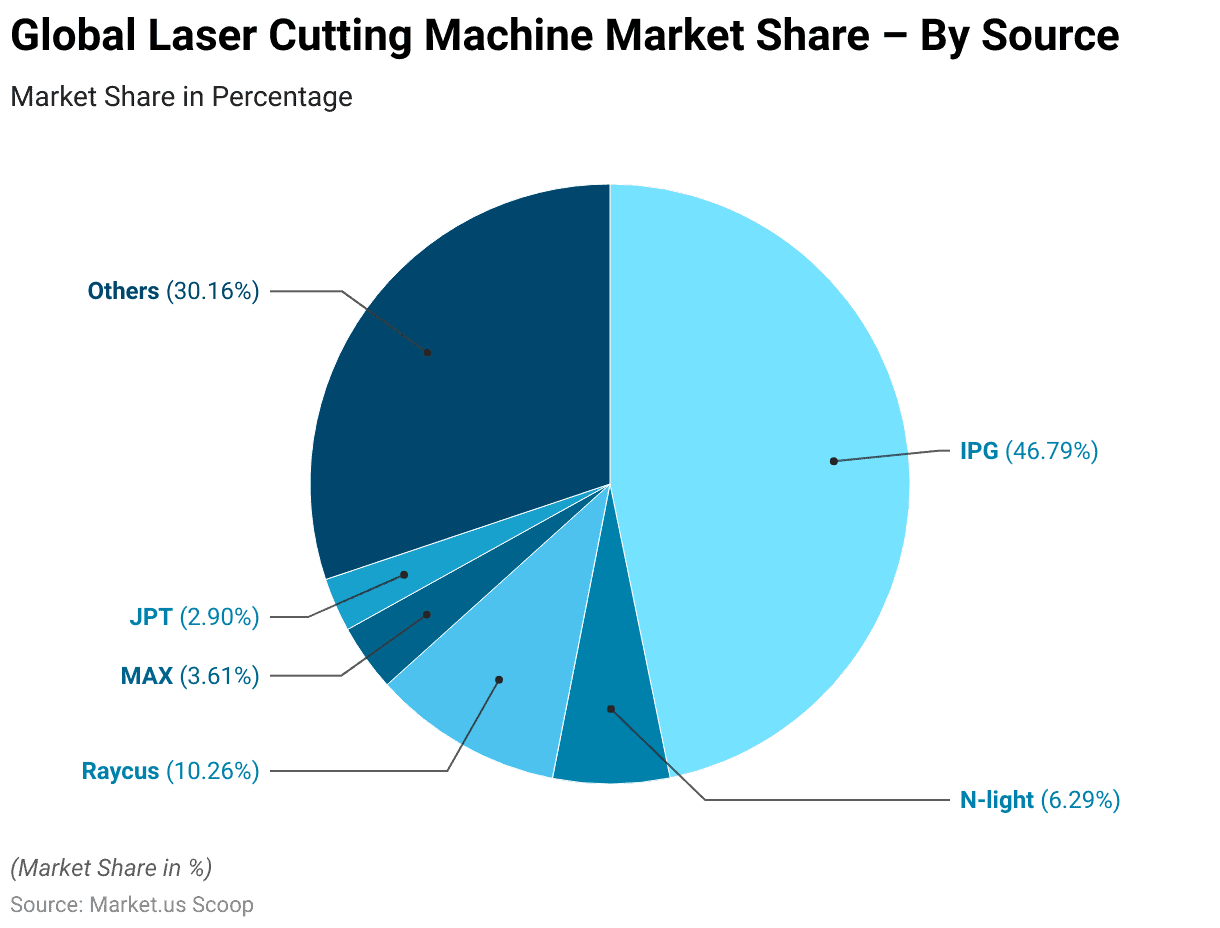
Global Laser Cutting Machine Market Share – By Application Statistics
- In 2019, the global laser-cutting machine market was primarily driven by material processing and lithography applications. Which together accounted for 44.3% of the market share.
- Communication and optical storage applications followed, contributing 26.8% to the overall market.
- Scientific research and military uses represented 9.3% of the market. While the medical and beauty sector accounted for 7.5%.
- Instruments and sensors made up 7.4% of the market share, and entertainment, display, and print applications contributed 3.2%.
- Other applications collectively represented the remaining 1.5% of the market.
- This distribution highlights the diverse range of industries relying on laser-cutting technology. With a significant emphasis on material processing and communication-related applications.
(Source: BLMA Machinery)
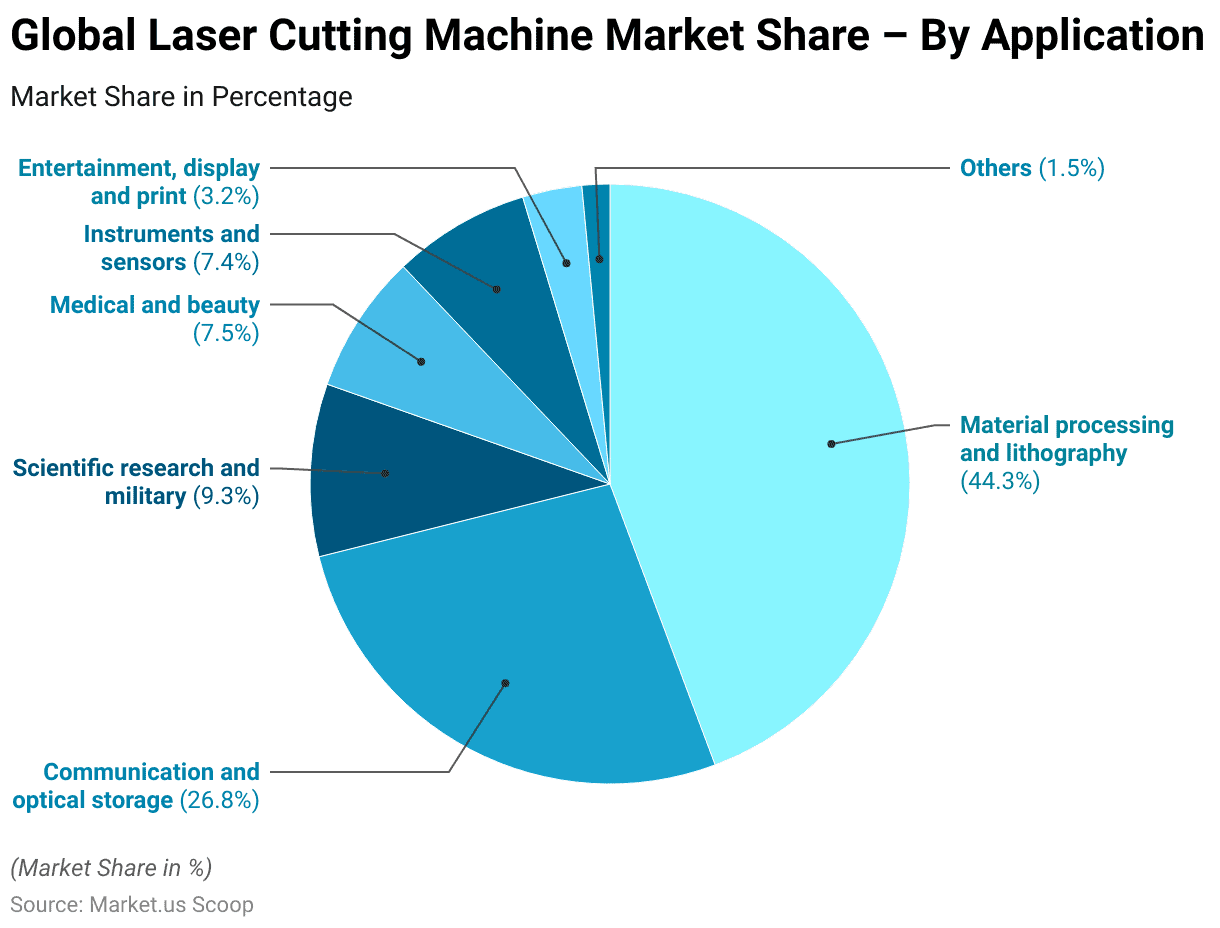
Competitive Landscape of the Global Laser Cutting Machine Market Statistics
- In the laser cutting machine market, Coherent Inc. holds the largest market share at 18%. Followed closely by Rofin-Sinar Technologies Inc., which accounts for 17% of the market.
- Kern Laser Systems and Amada Miyachi Co. Ltd. also have significant shares, representing 11% and 10% of the market, respectively.
- IPG Photonics Corporation and Trumpf GMBH + Co. Kg each command a 9% share, while Jenoptik Laser GmbH holds 8%.
- Epilog Laser Inc. contributes 6% to the market share, with other key players collectively accounting for the remaining 13%.
- This distribution underscores the competitive nature of the industry, with several companies holding substantial portions of the market.
(Source: market.us)

Regional Analysis of the Global Laser Cutting Machine Market Statistics
- The global laser-cutting machine market is geographically diverse, with North America leading the market share at 30.6%.
- The Asia-Pacific (APAC) region closely follows, accounting for 29.4% of the market. Reflecting the strong industrial and manufacturing growth in this area.
- Europe also plays a significant role, contributing 27.6% to the market share.
- South America represents 7.6% of the market, while the Middle East and Africa (MEA) region holds the remaining 4.8%.
- This distribution highlights the global reach and varied regional contributions to the laser-cutting machine market.
(Source: market.us)
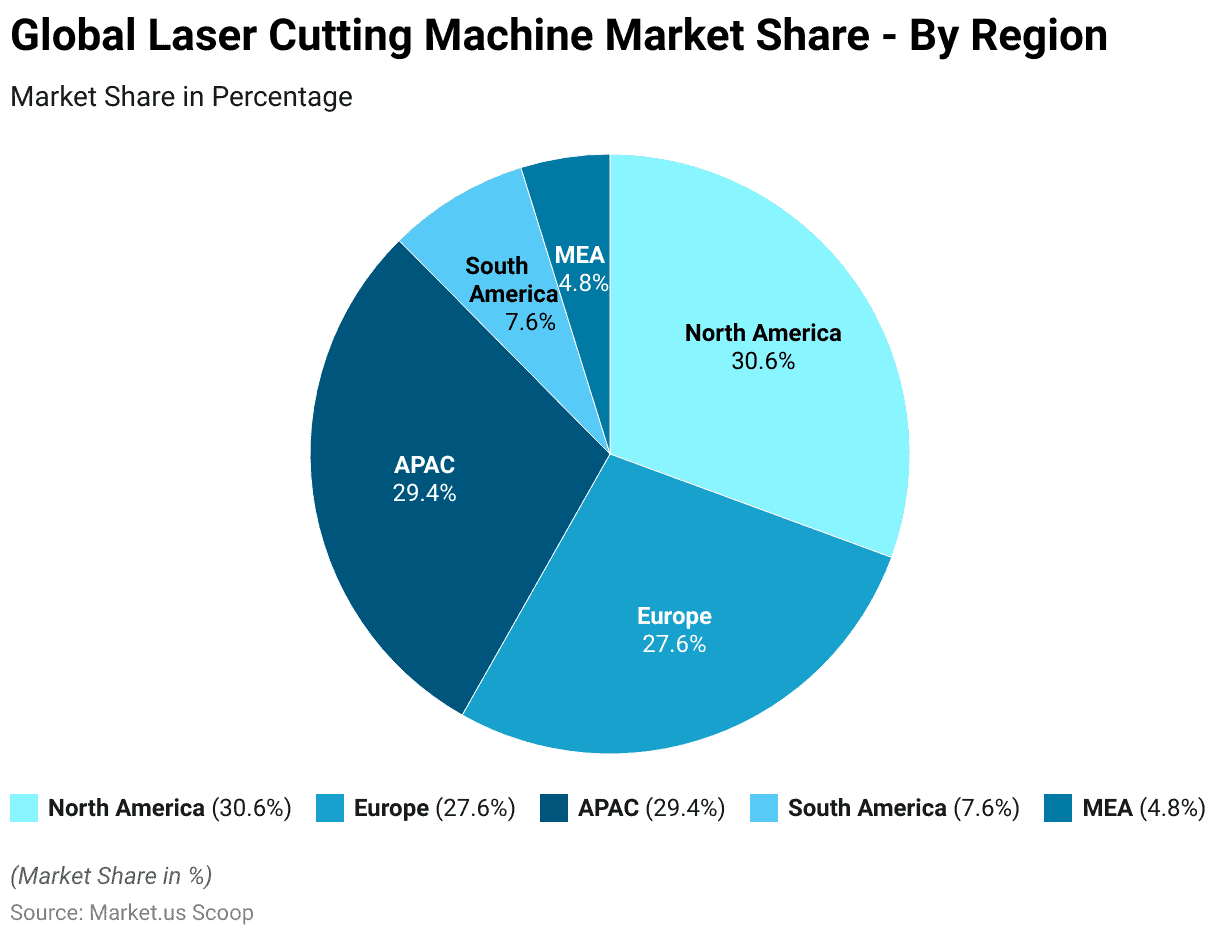
Key Export Statistics
- In 2022, Germany emerged as the leading exporter of electric, laser, and ultrasonic welding equipment. With an export value of USD 732 million, accounting for 24.3% of the global market.
- China followed with exports totaling USD 566 million, representing 18.8% of the market.
- Switzerland and South Korea also held significant shares, with export values of USD 293 million (9.75%) and USD 274 million (9.12%), respectively.
- Japan contributed USD 223 million in exports, making up 7.43% of the market. While the United States exported USD 215 million, accounting for 7.15%.
- Italy also played a key role, with exports totaling USD 193 million (6.43%).
- Other notable exporters included Mexico (USD 43.9 million, 1.46%), the United Kingdom and Turkey (each with USD 29.7 million, 0.99%), France (USD 28.9 million, 0.96%), Canada (USD 28.3 million, 0.94%), Chinese Taipei (USD 26.6 million, 0.89%), Spain (USD 26.4 million, 0.88%), and Hong Kong (USD 26 million, 0.86%).
- This distribution highlights the dominance of European and Asian countries in the global export market for welding equipment.
(Source: OEC World)
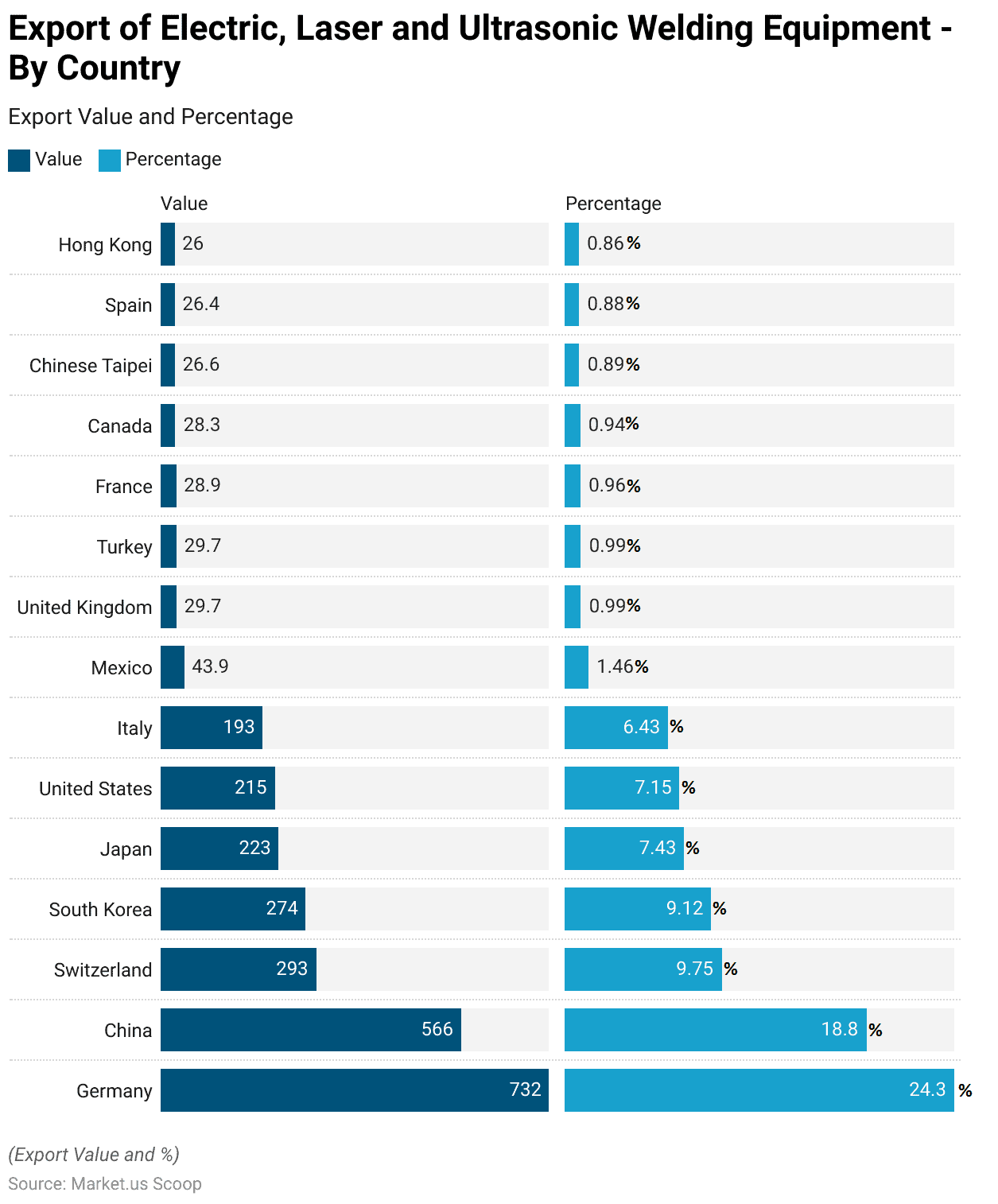
Key Import Statistics
- In 2022, the United States was the largest importer of electric, laser, and ultrasonic welding equipment. With an import value of USD 489 million, accounting for 16.3% of the global market.
- China followed as the second-largest importer, with USD 336 million in imports, representing 11.2% of the market.
- Germany imported USD 240 million worth of equipment, making up 7.97% of the market. While Mexico accounted for USD 206 million in imports or 6.86%.
- Other significant importers included India (USD 103 million, 3.44%), Vietnam (USD 96.3 million, 3.2%), and Poland (USD 70.2 million, 2.33%).
- The United Kingdom and South Korea also contributed with imports of USD 67.6 million (2.25%) and USD 64.2 million (2.13%), respectively.
- Canada and France each imported over USD 60 million, representing just over 2% of the market.
- Japan, Turkey, Russia, and Italy were also among the key importers, with values ranging from USD 57.7 million to USD 51.3 million, highlighting a broad global demand for welding equipment across diverse markets.
(Source: OEC World)
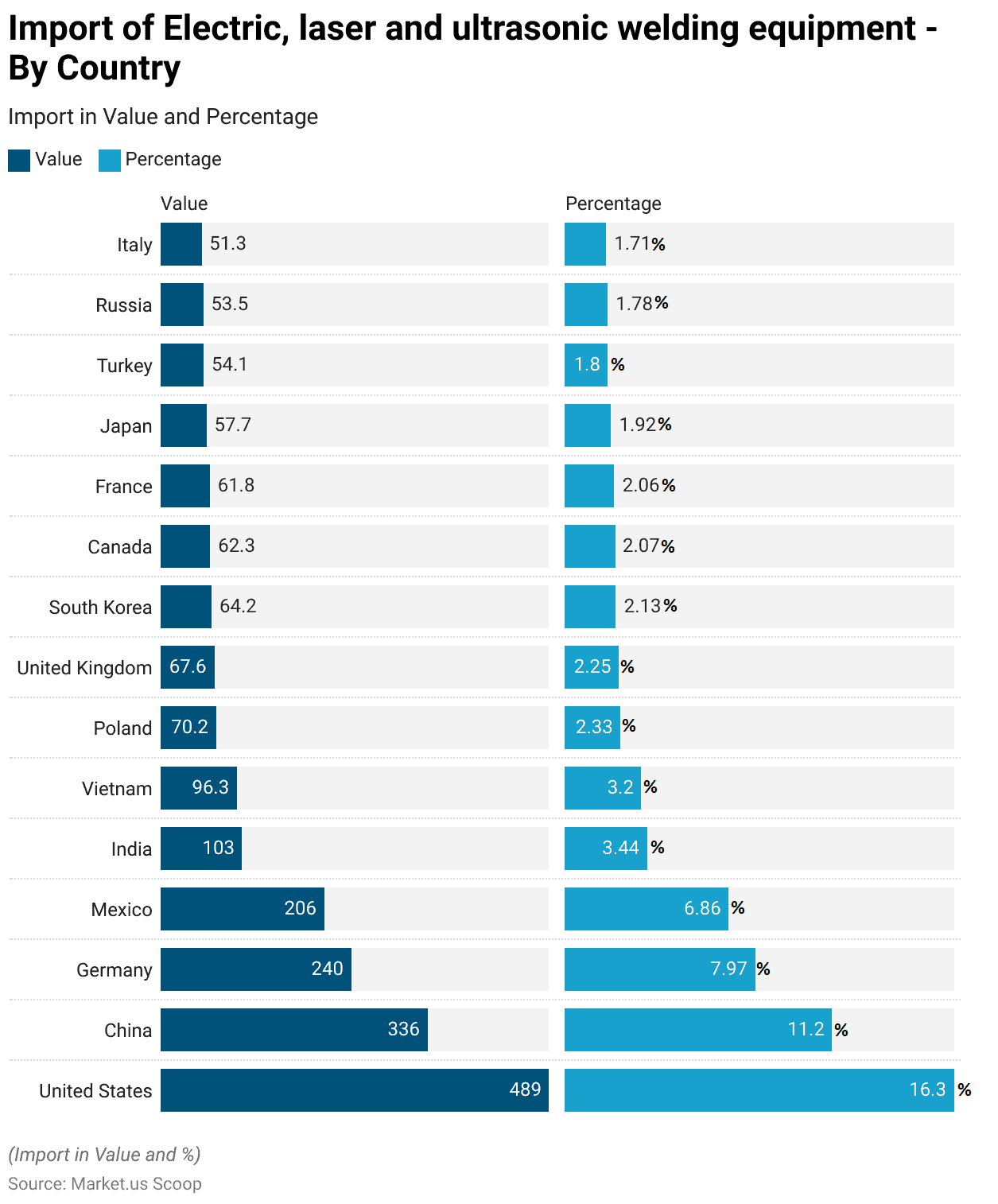
Laser Cutting Machine Specifications Statistics
Table Type Laser Cutting CNC Machine Statistics
- The machines are categorized by laser power, cutting head, and cutting thickness for both mild steel (MS) and stainless steel (SS), along with different model numbers and working sizes.
- For laser power of 1 kW, the Mini Cutter is available in models 1530, 1560, 2060, and 2560, capable of cutting mild steel up to 10 mm thick and stainless steel up to 5 mm thick. The working sizes for these models range from 1500 x 3000 mm to 2500 x 6000 mm.
- The 1.5 kW Mini Cutter offers an enhanced cutting thickness, with the ability to cut mild steel up to 13 mm and stainless steel up to 6 mm, available in the same model sizes and working dimensions as the 1 kW variant.
- The 2 kW Light Cutter improves on these specifications, enabling the cutting of mild steel up to 16 mm and stainless steel up to 8 mm. This cutter is available in models 1530, 1560, 2060, and 2560, with working sizes identical to those of the previous cutters.
- Further increasing capacity, the 3 kW Light Cutter can cut mild steel up to 20 mm and stainless steel up to 10 mm, available in the same models and sizes as the 2 kW Light Cutter.
- The 4 kW Light Cutter provides additional cutting capability, accommodating mild steel up to 24 mm and stainless steel up to 12 mm while maintaining the model numbers and working dimensions consistent with the previous cutters.
- Lastly, the 6 kW Pro Cutter offers the highest cutting performance, capable of cutting mild steel up to 25 mm and stainless steel up to 16 mm.
- This model is available in the same sizes as the other cutters, providing comprehensive cutting solutions across various thicknesses and materials.
(Source: Asia Machine Group)
Fiber Laser Cutting Machine FOL-3015AJ Statistics
- The Fiber Laser Cutting Machine FOL-3015AJ is a high-performance model equipped with a 4000W fiber laser, designed for precision and versatility in material cutting.
- This machine features a working range of 3100 x 1550 mm for the X and Y axes and a Z-axis travel of 100 mm.
- It boasts a repeatable positioning accuracy of ±0.01 mm, ensuring exceptional precision in cutting operations.
- The table can support a maximum load of 920 kg, accommodating a range of materials with varying thicknesses. The machine’s drive system utilizes a magnetic linear drive for enhanced performance.
- The overall dimensions of the machine, including the laser source and table, are 9930 mm in length, 2990 mm in width, and 2000 mm in height, with a total weight of 14200 kg.
- The FOL-3015AJ is capable of cutting various materials with maximum thicknesses of 22 mm for mild steel, 18 mm for stainless steel, 16 mm for aluminum, and 8 mm for both brass and copper.
(Source: AMADA)
Vueming Laser Engraving Machine VMA 1390 4×3 Feet 100w
- The Vueming Laser Engraving Machine, model VMA 1390, is a CO2 laser cutting and engraving machine with a 4×3 feet working area.
- It features a 100W Reci W2 laser tube, offering robust cutting and engraving capabilities.
- The machine is priced at ₹350,000 for a complete set.
- The configuration includes a working table with both a blade and a honeycomb table to accommodate various materials. It is equipped with a single laser head and is controlled by a RUIDA 6442S system.
- The driver system employs Leadshine stepping motors and drivers, and it utilizes Taiwan CSK linear guideways for smooth operation.
- Additionally, the machine is cooled by an S&A CW5000 water chiller to ensure optimal performance and longevity.
(Source: VM Technology)
CX-CC6050L High Precision Laser Cutting Machine Statistics
- The CX-CC6050L High Precision Laser Cutting Machine is designed for advanced precision and performance.
- This model operates at a laser wavelength of 1080±5 nm and offers an average output power ranging from 500 to 3300W.
- It achieves a minimum line width of ±0.01 mm and maintains a repetitive positioning accuracy of ±0.01 mm, ensuring exceptional cutting precision.
- The machine supports a maximum cutting speed of 60 m/min and can accelerate at up to 1.5G.
- It is capable of continuous operation for at least 20 hours, providing reliable performance for extended periods.
- The cutting range of the CX-CC6050L measures 595 mm × 595 mm, and it is powered by a 380VAC±10%, 50Hz power supply. The transmission method utilizes linear motors, contributing to the machine’s high efficiency.
- Its overall dimensions are 1900 mm in length, 1450 mm in width, and 1800 mm in height.
(Source: Chlaser)
LS1000XP – Laser Engraver & Cutter – Gravotech
- The LS1000XP Laser Engraver and Cutter, equipped with a CO2 laser source from Gravotech, is designed for efficient and precise engraving and cutting tasks.
- This machine supports a maximum object weight of 25 kg (55.2 lb) and adheres to CDRH Class 2 laser safety standards.
- Its dimensions are 1660 mm in length, 1160 mm in width, and 800 mm in height (65.4 x 45.7 x 31.5 in), with a total weight of 220 kg (485 lb).
- The engraver features a point-and-shoot functionality and connects to computers via USB.
- It operates using Gravostyle software and has a beam diameter ranging from 0.1 mm to 0.4 mm (0.004 to 0.016 in).
- The noise level is maintained at or below 66 dB, and the operating temperature ranges from 10°C to 35°C (50°F to 95°F).
- Additionally, the machine includes an automatic Z-axis with a travel range of 300 mm (11.8 in) and achieves maximum speeds of up to 4000 mm/s (157.5 in/s).
(Source: Gravotech)
SIL Laser Engraving Machine – ACCUCUT E1325
- The SIL Laser Engraving Machines, under the ACCUCUT series, offer a range of models suited for various applications.
- The models include the AccuCut 1325, AccuCut 1212, AccuCut 1390, AccuCut 6090, and AccuCut 6040, with working areas of 1300×2500 mm, 1200×1200 mm, 1300×900 mm, 600×900 mm, and 600×400 mm, respectively.
- These machines utilize either a CO2 DC glass laser tube or an RF metal laser tube, with laser power options varying from 60 to 150 watts for the glass tube and 40 to 200 watts for the metal tube.
- The laser operates at a wavelength of 10.6 μm. They are powered by AC 230 V ±0.05% or AC 415 V ±0.05% supply voltage.
- The machines feature a maximum reposition accuracy of 0.1 mm, a cutting speed of up to 30,000 mm/min, and an engraving speed of up to 64,000 mm/min.
- They are cooled by water and utilize LM guide rails from SIL Brand for the X and Y axes.
- The work environment should be maintained between 0°C and 45°C in temperature and 5% to 95% in humidity. The machines are capable of acceleration speeds up to 1 G.
(Source: Silasers)
Hindcam 6KW-Laser Cutting Machine Statistics
- The Hindcam 6KW Laser Cutting Machine is designed for high-performance cutting with a 6KW laser power sourced from either Raycus or Maxphotonics.
- It operates using the Cypcut 2000 or Cypone system and is equipped with servo motors from Yashkava, Innovation, or Fuji.
- The cutting bed size is customizable, ranging from 1500 mm to 3000 mm, and the bed can be made of either heavy plate or cast iron.
- The machine features 30mm Taiwan Brand guide rails and employs a dual bed exchange platform for efficient sheet cutting.
- It includes an SMC gas controller and provides repeatability of 0.03 mm with a cutting precision of 0.1 mm.
- The machine can achieve accelerations of up to 30 m/s² and uses BM 115 and BM 114 cutting heads.
- An S&AC water chiller manages to cool. It supports cutting capabilities of up to 30 mm for mild steel, stainless steel, and brass.
- The starting price for this machine is Rs 4,750,000 plus GST, and it comes with a two-year warranty.
(Source: Hindcam)
Laser Cutting Carbon Steel with Assist Air Gas
- A trend illustrates the cutting speed of carbon steel with assist air gas across varying thicknesses using different laser power levels, ranging from 12 kW to 40 kW.
- At a thickness of 6 mm, the cutting speed increases with laser power, starting from 16 units at 12 kW and reaching up to 33 units at 40 kW.
- For 8 mm thickness, the speed ranges from 10 units at 12 kW to 25 units at 40 kW. As the thickness increases to 10 mm, the cutting speed starts at seven units with 12 kW and goes up to 18.5 units with 30 kW.
- For 12 mm thickness, the speed is four units at 12 kW and reaches 18.5 units at 40 kW, demonstrating a significant increase with higher power. At 16 mm, the cutting speed begins at 3.5 units with 15 kW, reaching 12 units at 40 kW.
- For thicker materials, such as 20 mm, the cutting speed is two units at 15 kW and increases to 12 units at 40 kW. In the case of 25 mm thickness, the cutting speed is two units at 20 kW and goes up to 5.5 units at 40 kW.
- For 30 mm thickness, only higher power levels (30 kW and 40 kW) are effective, with speeds of 2.7 and 4.5 units, respectively.
- For even greater thicknesses, such as 35 mm and 40 mm, the cutting speed is achievable only with 40 kW, registering speeds of 3.2 and 2.3 units, respectively.
- This data demonstrates the necessity of higher laser power to maintain cutting speed as material thickness increases.
(Source: Laser Focus World)
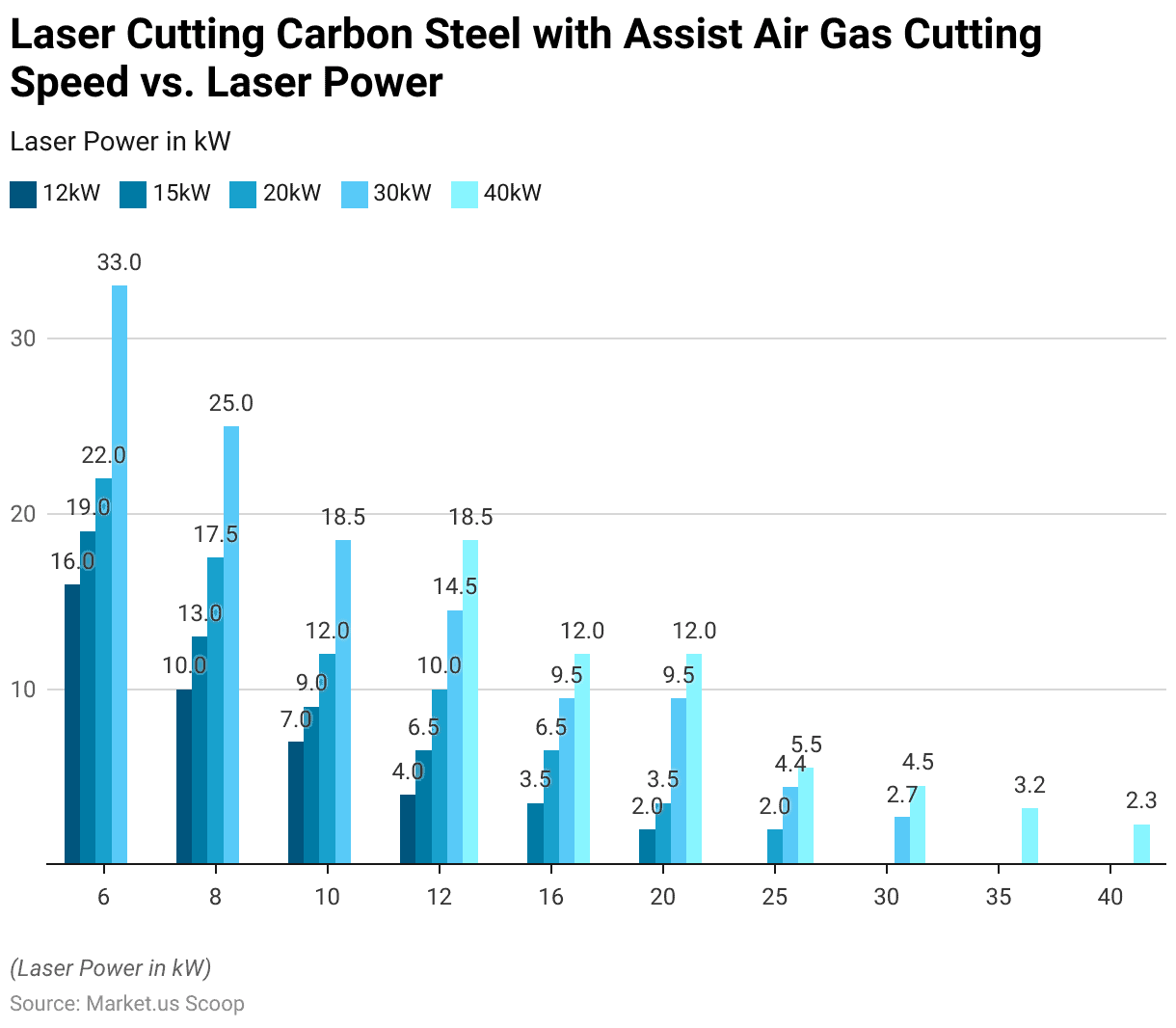
Innovations in Laser Cutting Technology
- Innovations in laser cutting technology are driving significant advancements in the manufacturing and fabrication industries. With key developments enhancing precision, efficiency, and versatility.
- Ultrahigh-power fiber lasers and all-silicon lasers are at the forefront, offering cutting speeds and accuracy previously unattainable. Which are transforming sectors like automotive, aerospace, and healthcare.
- The integration of AI, Big Data, and IoT within laser cutting systems has further optimized processes through real-time data analysis and predictive maintenance. Leading to reduced costs and energy consumption.
- Additionally, the emergence of 3D laser cutting is expanding the potential applications of this technology, particularly in complex design and material customization.
- These advancements not only improve operational efficiency but also align with environmental goals by reducing waste and energy usage, marking a promising future for the industry.
(Sources: Type Laser, Style CNC, Laser 24)
Regulations for Laser Cutting
- Regulations surrounding laser cutting technology are essential for ensuring safety and compliance across various industries.
- In the European Union, laser devices, including those used for cutting, must adhere to several stringent standards, such as EN 60825 for laser product safety, which classifies devices based on their hazard levels and sets out specific requirements to mitigate risks.
- Additionally, the Machinery Directive mandates that laser equipment integrated into machinery be designed to prevent accidental radiation exposure, ensuring user safety.
- In the United States, individual states like California have also started regulating the use of lasers in medical and industrial applications. With recent legislation expanding the scope of practice for professionals, including optometrists, to perform certain laser procedures under strict guidelines.
- These regulations are complemented by directives such as the Low Voltage Directive and RoHS, which control the safety and environmental impact of laser products, ensuring they do not pose risks through electromagnetic interference or hazardous substances.
- Together, these regulations create a robust framework that governs the safe use of laser cutting technology in both industrial and medical fields.
(Sources: Compliance Gate, Laser 24, Review of Optometry)
Recent Developments
Acquisitions and Mergers:
- Trumpf acquires Active Fiber Systems: In 2023, Trumpf, a global leader in laser cutting technology, acquired Active Fiber Systems for $150 million. This acquisition is expected to enhance Trumpf’s laser cutting capabilities by integrating fiber laser technology, making their machines more efficient for industrial applications.
- Amada merges with Lantek: Amada, a prominent manufacturer of laser cutting machines, merged with software company Lantek in mid-2023. This merger, valued at $200 million, aims to integrate advanced software solutions with laser-cutting machines. Allowing for better automation and real-time data analytics in industrial cutting processes.
New Product Launches:
- Bystronic’s New Fiber Laser Cutter: In early 2024, Bystronic launched a new 15kW fiber laser cutting machine, which offers faster cutting speeds and higher precision. This machine is designed for high-volume production, particularly in the automotive and aerospace industries, and is expected to set a new standard for efficiency and precision in laser cutting.
- Mazak introduces OPTIPLEX 3015 NEO: In 2023, Mazak launched the OPTIPLEX 3015 NEO, a next-generation laser cutting machine featuring intelligent beam shaping and adaptive control systems. This machine enhances cutting speed and accuracy, reducing operational costs by optimizing energy consumption.
Funding:
- Prima Power secures $100 million in funding: In 2023, Prima Power, a leader in sheet metal cutting and automation. Raised $100 million in funding to expand its R&D for laser cutting technologies. The funds will be used to develop more advanced, sustainable laser-cutting machines targeting the automotive and renewable energy sectors.
- LVD Group receives $50 million for expansion: LVD Group is a global player in metalworking and laser cutting. Received $50 million in 2024 to invest in green laser-cutting technologies. This funding will help LVD develop machines with reduced energy consumption and lower environmental impact. In line with the growing demand for sustainable manufacturing solutions.
Technological Advancements:
- AI in Laser Cutting Machines: The integration of AI and machine learning in laser cutting machines is transforming the industry. These technologies allow machines to adjust cutting parameters in real-time based on material properties. Leading to higher precision and reduced material waste. By 2025, AI-powered laser cutting systems are expected to account for over 25% of the market, significantly improving automation in manufacturing.
- Ultrafast Lasers for Micromachining: Recent advancements in ultrafast laser cutting technology have made it possible to achieve micron-level precision. Especially useful in medical device manufacturing and electronics. Ultrafast lasers are projected to grow by 10% annually as demand for precise, clean cuts in micro-applications increases.
Market Dynamics:
- Growth in Laser Cutting Machine Market: This growth is fueled by increasing demand in industries like automotive, aerospace, and electronics. Where precision cutting is critical for high-performance applications.
- Rising Demand for Fiber Laser Cutting Machines: Fiber laser cutting machines are gaining popularity due to their high efficiency and lower operational costs. By 2024, fiber laser machines are expected to account for nearly 60% of the total market, reflecting a shift from traditional CO2 laser systems.
Conclusion
Laser Cutting Machine Statistics – Laser cutting, especially with high-power lasers from 12 kW to 40 kW, is highly effective for processing materials like carbon steel.
The data shows a clear link between laser power, cutting speed, and material thickness: as thickness increases, higher laser power is needed to maintain efficient cutting.
Lower-power lasers work well for thin materials, but thicker ones require more power to ensure productivity.
Moreover, this capability makes laser cutting versatile and well-suited for industries such as automotive, aerospace, and heavy machinery, where precision and efficiency are crucial. Properly matching laser power to material thickness is key to optimizing laser cutting performance.
FAQs
Laser cutting is a precise manufacturing process that uses a high-powered laser beam to cut, engrave, or shape materials such as metal, plastic, wood, and textiles.
Laser cutting works by focusing a high-intensity laser beam onto a material, which either melts, burns, or vaporizes the material along a specified path, creating clean and accurate cuts.
Laser cutting can be used on a wide range of materials. Including metals (such as steel, aluminum, and titanium), plastics, wood, glass, ceramics, and even fabrics.
Laser cutting offers high precision, speed, and flexibility. It can produce complex shapes with tight tolerances and smooth edges, reduces material waste, and requires minimal post-processing.
Common types of lasers used in laser cutting include CO2 lasers, fiber lasers, and solid-state lasers. Each type is suited to specific materials and applications.
The thickness of materials that can be cut depends on the laser power. Higher-power lasers can cut thicker materials, with some lasers capable of cutting metals up to several inches thick.
While laser cutting is versatile, it may not be suitable for all applications. For example, certain materials like highly reflective metals or those with a low melting point may require special considerations or alternative cutting methods.
Discuss your needs with our analyst
Please share your requirements with more details so our analyst can check if they can solve your problem(s)



